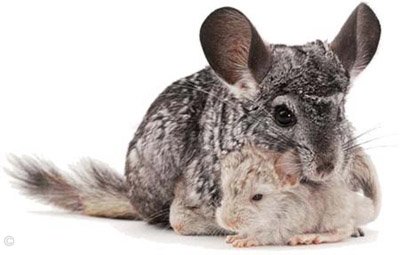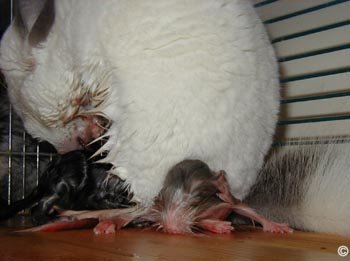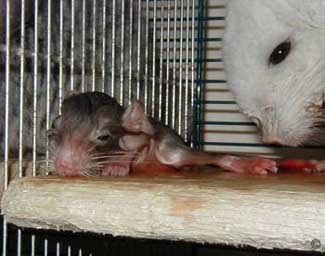 Chinchillas have been giving birth on their own in the wild (and captivity) for years and usually do not need the help from human interaction. Saying this, it is important that you over-see the birth process from start to finish to ensure no complications arise or go un-missed. If at any point birthing complications do arise, it is paramount that you call an experienced veterinary surgeon if the chin-mother and kits are to survive.
Chinchillas have been giving birth on their own in the wild (and captivity) for years and usually do not need the help from human interaction. Saying this, it is important that you over-see the birth process from start to finish to ensure no complications arise or go un-missed. If at any point birthing complications do arise, it is paramount that you call an experienced veterinary surgeon if the chin-mother and kits are to survive.
There is no need to remove the male during birth unless he becomes a nuisance to the female and she begins to show aggression towards him. Usually the male will aid the female and attend to the kits with cleaning, drying and the after-birth but if the female shows hostility or stress at any point, the male will need to be removed from the maternal cage and placed into a separate cage next to the female.
Most owners miss the miracles of birth as the kits are generally born in the late evening - early hours of the morning. A gestation chart will help you determine when chinchilla kits are due so you can arrange your day around the birth time and be there if needed.
The onset of labor is exposed by contractions in the uterus and the female becoming increasingly uncomfortable and vocal. As the delivery time nears, you will notice the female generally rear up onto her hind legs and regularly clean the vaginal area, which will now show signs of opening as the kit continues down the birthing canal. The fur around the area will also be evidently wet from the release of birth fluid.
The female will vocalize teeth grinding noises as the kit's head becomes visible and once exposed the female will bend forward and start cleaning away the birth sac from the kit's face, ensuring the face is clean and the sac has been fully removed causing no blockages to the kit's breathing.
 Once the face has been cleaned, the female will contract again and grasp the kit with her teeth and pull the kit out in its entire. At this stage, the female may deliver the after-birth depending on how many remaining kits there are.
Once the face has been cleaned, the female will contract again and grasp the kit with her teeth and pull the kit out in its entire. At this stage, the female may deliver the after-birth depending on how many remaining kits there are.
If there is more than one kit the contractions for the second start shortly after the first and the same sequence of events will occur. Delivery of only one after-birth and two kits will mean the kits are twins but if after the second kit there is another after-birth you can safely say the siblings have developed individually and are independent kits.
As soon as the kits are born, the female will attend to cleaning and drying her offspring with the use of her face and fur before nudging them under her to feed, which encourages milk flow as well as aiding the kits to stay warm. This process is compulsory if the kits are to survive and not be left to dry on their own, as doing so, the kit will become cold and die. If the female is preoccupied, the male will help at this stage but if he is not available, then it is vital you intervene.
You will need to remove the vulnerable kit by cupping it gently in your hands. If the kit is experiencing breathing difficulties, you will need to gently breath into its face to aid respiration. Keeping the kit held gently in your hands will help warm and dry the wet kit but you can speed the process up by carefully using a warm soft towel and drying the kit's fur. When the kit is dry, it can be placed back into the mother's cage. Observations must be made to see if the kit feeds from the chin-mum and caution should be maintained incase the mother rejects the kit and attacks it, instead of nudging and encouraging it to feed.
The whole birth process takes anywhere between 1-2 hours with very little loss of blood. Labor stages are generally quite short and last approximately 30 minutes-1 hour with an interval of 1-2 hours between kits.
 WARNING - The maximum delivery time from the commencement of labour to actual birth is 3-4 hours. If chinchilla kits have not been born by this time it is seriously important to call a veterinary surgeon to determine the cause for the non delivery of foeti. By calling a veterinary surgeon at the earliest signs of any birth complication there is a good chance of being able to save the female and most, or all, of the kits.
WARNING - The maximum delivery time from the commencement of labour to actual birth is 3-4 hours. If chinchilla kits have not been born by this time it is seriously important to call a veterinary surgeon to determine the cause for the non delivery of foeti. By calling a veterinary surgeon at the earliest signs of any birth complication there is a good chance of being able to save the female and most, or all, of the kits.
You should very gently feel the chin-mum's stomach 4 hours after birth to firstly check it is warm, as if not, there may not be enough milk being produced and you may need to hand feed the babies yourself for them to survive. Secondly, if you detect lumps and the contractions have stopped, there is an unfortunate chance  of a trapped/dead kit still inside and you must call a veterinary surgeon immediately.
of a trapped/dead kit still inside and you must call a veterinary surgeon immediately.
WARNING - Female chinchillas will experience a post parturient heat 12 hours after giving birth and for a further 7 days thereafter, which will mean during this time she can become pregnant again (known as Back Breeding).
If the male remains in the maternal home, it is paramount to observe his interactions with the new offspring and female immediately after the birth to ensure he is interacting appropriately with the kits and not likely to attack them and also to ensure no back breeding occurs. To completely prevent the chances of 'back breeding' the male will need to be re-housed in a separate cage next to the maternal cage for a minimum of 7 days after birth although 10 days is safer.
BIRTH COMPLICATIONS
Occasionally birthing complications can arise and if you notice the female looking exhausted, restless with no delivery of kits or continued restlessness after the kits are born, excessive vocal sounds or loss of blood then you MUST call a veterinary surgeon immediately.
Birthing complications can arise from a number of unfortunate circumstances, for example, one of the foetus may not be able to pass through the birth canal in the normal manner or the foetus may have become lodged in the birth canal with its head bent between its legs. Two foetuses may haven become lodged together or offspring can be deformed with unusually large heads or larger than average body size,  making it difficult to pass through the birthing canal without some extra help.
making it difficult to pass through the birthing canal without some extra help.
A 'breach position' can be seriously dangerous as the foetus is expelled backwards, feet first and are unable to pass through the birth canal unaided. Undernourished, weak, thin, overly bred females can also experience birthing complications due to lack of sufficient strength and ability to successfully give birth on their own.
Sadly, there are times when a foetus will die in the uterus a short time prior to the normal birth time. These foetus are 'still born' and not in all cases are they delivered. If this happens, you will notice a female appear uneasy after it is thought that she has completed littering and she will have a tendency to neglect the kits that have just been born. Any still born kits must be removed as the situation can become fatal to a female through toxification and mummified kits blocking the uterine tubes for future breeding success.
Lack of milk supply can also be a problem especially in over sized litters or with females that cannot lactate, a condition known as Agalactia. The causes for the complete absence of milk at birth is unknown but may be linked with insufficient development of the milk glands. It can occur when breeding a female that is too young or under developed, unfit or malnourished of vital nutrients or caused by a genetic pass down.
Female chinchillas produce full milk flow approximately 3 days after the litter is born, until that time the secretion of milk can be scanty and insufficient to feed a large litter especially if there are 3+ offspring.
The first indication that there is insufficient or no milk will be the kits continual whining and weight loss. The kits may attempt to suckle or pull at the teat but are unsuccessful in obtaining any or enough milk, consequently they become hungry, restless, nervous and overly aggressive towards siblings and the mother's nipple itself. The female will appear irritable and if the kits continue to annoy her, she can have a tendency to snap at them and as a result they can be bitten so severely they can die from the injury.
Chinchilla kits that do not feed sufficiently after birth will become thin and gradually grow weak and die if no interaction is made. Weaker kits are not so vigorous nor are they able to suckle as readily as their stronger and more robust siblings. Special attention must be given to any kit that is not receiving sufficient nourishment after birth as they will die from slow starvation.
Finally a female may for some reason, neglect her offspring for what ever reason and if this should happen, you must be prepared to act as parent and carer by hand rearing the kit yourself.
The Chinchilla A-Z Health & Sickness Bible discusses in detail the various birthing complications and how to prevent them. This fantastic ebook is a 'must have' for any chinchilla owner thinking of breeding. Read more
Further Reading Relating To Chinchilla Birth:
Breeding, Chinchilla Kits, Hand Feeding, Minerals & The Relation To Chinchilla Disease, Pregnancy, Pre & Post Natal Care, Vitamins & The Relation To Chinchilla Disease, Weaning Chinchilla Kits.


 Chinchillas have been giving birth on their own in the wild (and captivity) for years and usually do not need the help from human interaction. Saying this, it is important that you over-see the birth process from start to finish to ensure no complications arise or go un-missed. If at any point birthing complications do arise, it is paramount that you call an experienced veterinary surgeon if the chin-mother and kits are to survive.
Chinchillas have been giving birth on their own in the wild (and captivity) for years and usually do not need the help from human interaction. Saying this, it is important that you over-see the birth process from start to finish to ensure no complications arise or go un-missed. If at any point birthing complications do arise, it is paramount that you call an experienced veterinary surgeon if the chin-mother and kits are to survive. Once the face has been cleaned, the female will contract again and grasp the kit with her teeth and pull the kit out in its entire. At this stage, the female may deliver the after-birth depending on how many remaining kits there are.
Once the face has been cleaned, the female will contract again and grasp the kit with her teeth and pull the kit out in its entire. At this stage, the female may deliver the after-birth depending on how many remaining kits there are. WARNING - The maximum delivery time from the commencement of labour to actual birth is 3-4 hours. If chinchilla kits have not been born by this time it is seriously important to call a veterinary surgeon to determine the cause for the non delivery of foeti. By calling a veterinary surgeon at the earliest signs of any birth complication there is a good chance of being able to save the female and most, or all, of the kits.
WARNING - The maximum delivery time from the commencement of labour to actual birth is 3-4 hours. If chinchilla kits have not been born by this time it is seriously important to call a veterinary surgeon to determine the cause for the non delivery of foeti. By calling a veterinary surgeon at the earliest signs of any birth complication there is a good chance of being able to save the female and most, or all, of the kits. making it difficult to pass through the birthing canal without some extra help.
making it difficult to pass through the birthing canal without some extra help.